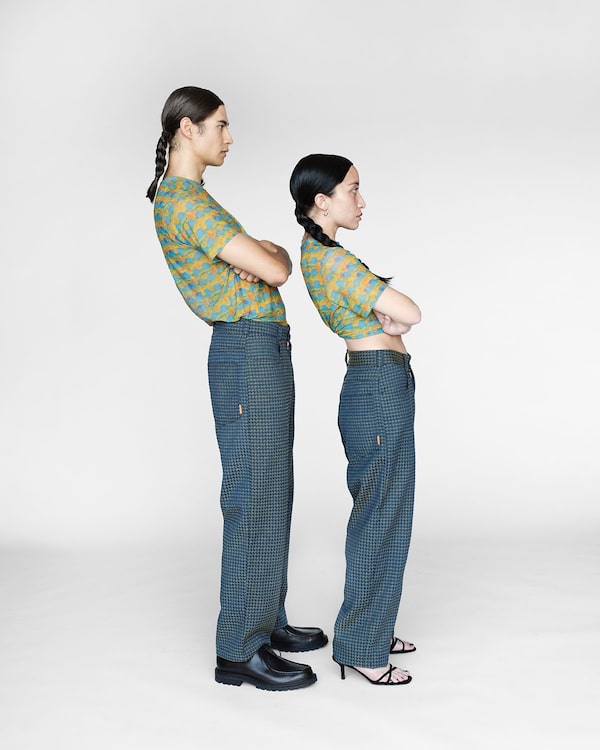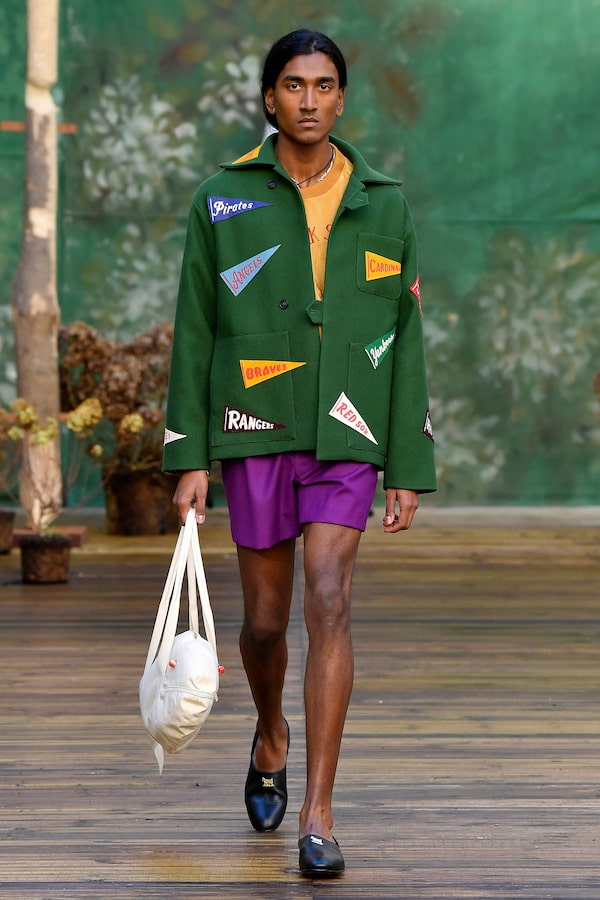
The pandemic has led to a quicker shift toward a greener future in fashion, especially when it comes to sourcing materials.Handout
When Jamie Dawes debuted her clothing brand Fyoocher last April, she assumed she’d have to take on a part-time job while building the business. With a pandemic keeping people indoors and priorities for disposable income shifting, she predicted a slower start for her collection of novelty pants. But Dawes was wrong.
“As soon as I launched, for the first two months, it was insane. It was like Black Friday,” she says. Through Fyoocher’s website, Dawes sells about 20 pairs of pants a month. They’re all made using upcycled fabrics sourced from an appointment-only supplier housed in a Vancouver warehouse.
Dawes, a former fast-fashion shopper, partially credits the success of her brand and others like it to millennials' rising climate anxiety and interest in ethical manufacturing. “People want to see transparency,” she says. “They want to know where their clothing comes from.”
Sustainability has long been a buzzword on every fashion marketer’s lips. But as COVID-19 abruptly disrupted the fashion industry, the pandemic has led to a quicker shift toward a greener future, especially when it comes to sourcing materials. Over the past year, fabric suppliers either temporarily or permanently shuttered and forced designers to make do with leftover fabric and notions from past seasons. This sort of upcycling – the process of creating new clothes out of deadstock, secondhand or vintage materials – has become a key way brands have figured out how to help people, the planet and their profits.

Jamie Dawes's clothing brand Fyoocher sells pants made from upcycled fabrics.Handout
As the fashion cycle accelerated over the past three decades, demand for constant novelty and hype has often come at the expense of innovative ideas and individuality, while contributing to the deterioration of the planet and its natural resources. Emerging labels such as Fyoocher and Collina Strada, along with established brands including Bode, Marine Serre and Gabriela Hearst, are out to change this. To varying degrees, each brand crafts unique, covetable and luxurious clothes from upcycled fabrics.
“The stories of upcycling are much better told when we call them what they are,” says Kate Fletcher, a professor of sustainability, design and fashion at the Center for Sustainable Fashion at the University of the Arts in London. “Reuse fabrics by trying to add design value to them.”
For Helen Frank, a Toronto-based textile mender and owner of Helen Mends, introducing consumers to upcycled garments educates them about where their clothes are made, and connects them to the items’ purpose and provenance. “It’s so easy right now for people to have the story of their garment completely hidden from them and detach themselves from the reality of how it’s made,” Frank says. “By upcycling, you’ve immediately brought part of the story of where the item comes from to the consumer.”
On a larger scale, Our Legacy Workshop, a sub-brand of Sweden’s Our Legacy, has been reworking excess fabrics from its Portugal factory for years. The line, which makes up about 20 per cent of Our Legacy’s business, serves as a platform for experimental design and sustainable production. “We created this dream concept where it’s half-studio, half-store, and we can kind of rework stuff,” co-founder Jockum Hallin says.

Bode is among the established brands that crafts unique, covetable and luxurious clothes from upcycled fabrics.Handout
Our Legacy Workshop’s collaboration with California streetwear brand Stüssy saw each company use the other’s leftover fabrics to create updated iterations of classic styles – and sold out almost immediately. “If the garment is right and very appealing, it doesn’t really matter [what the price is],” Hallin says. “People are ready to pay more if there’s only a couple of pieces made.”
Dawes, who prices Fyoocher’s clothing in the low hundreds, was initially concerned about making her line accessible to millennial shoppers. However, she’s found that they are willing to invest in something unique (the fabrics Dawes sources usually yield only two or three pieces). “I think [rarity] really intrigues people because they don’t want to be wearing the same clothes as everyone else,” she says.
The pandemic push toward widespread wearing of face masks has also seen many designers and makers crafting reusable masks from upcycled materials as a low-waste option that works to help limit transmission of the coronavirus. Frank has made more than 2,000 masks from repurposed textiles and is working with The ROSE Project – an acronym for Reusable Open Source Equipment – to develop a hospital-grade reusable mask that’s currently being lab-tested for breathability and filtration.
The rise of upcycling is part of a broader shift toward a circular fashion economy that also includes a boom in reselling clothing and other items, and a push for recycled fur in winter outerwear. Fletcher says these changes empower consumers to participate more in the full life cycle of their clothes, and consider the value of what’s hidden away at the back of their closets. As she puts it: “Maybe the most radical garment is the one you already own.”
Sign up for the weekly Style newsletter, your guide to fashion, beauty and design, and follow us on Instagram @globestyle.